The Devil's Farmhouse
| The Devil's Farmhouse | |
|---|---|
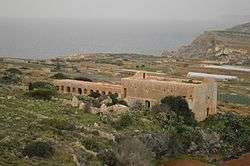 View of The Devil's Farmhouse | |
| General information | |
| Status | Intact |
| Type |
Farmhouse Stables Horse-riding school |
| Architectural style | Vernacular |
| Location | Mellieha, Malta[1] |
| Coordinates | 35°57′21″N 14°20′59″E / 35.95583°N 14.34972°E |
| Named for | The devil |
| Completed | 18th century |
| Owner | Government of Malta |
| Technical details | |
| Material | Limestone |
| Floor count | 1 |
| Design and construction | |
| Architect | Unknown |
The Devil's Farmhouse, also known in Maltese as Ir-Razzett tax-Xitan,[2] and officially as Ir-Razzett Tax-Xjaten (The Farmhouse of the Devils or The Devils' Farmhouse),[3] is an 18th-century farmhouse in Mellieha, Malta.[4] The farmhouse features two unconnected buildings. The original scope for the buildings were to function as stables and a horse-riding school (Cavalerizza). At one point the buildings were converted into farmhouses between different farmers, and the buildings underwent some structural changes.[5] A national Maltese myth claims the farmhouse was built by the devil, a tale from which it derives its historic name. It is a national monument and in a dilapidated state.
History
The Devil's Farmhouse was built in the 18th century[4] during the Order of St. John to be used as a horse stable. It is found in an area known as Ta' Randa[6] very close to L-Ghar ta' Zamberat (Ta' Zamberat's Cave). The farmhouse stands away from urban development in isolation. Attributed to the farmhouse is a Maltese myth that the farmhouse was built by the devil (or devils) in one day (or three days).[7][8][3] The only architectural feature that gives the impression of relating to demonic icons are the two enclosed staircases, that lead to the roof of the stable, which are suggested to appear as two horns.[6][7]
There is also a traditional carnival song (or poem) that mentions Ta' Randa and the devil. The song (or poem) named Il-Karnival goes to say as the following:
Għax illum il-Karnival
Għax il-festa tax-xitan
Ix-xitan irid ikanta
Għandu denbu daqs ta' Randa.[9][10]
Very roughly translated, this text announces the feast of the devil at the site.
Architecture
The building has a simple and modest vernacular architecture,[11] with slit windows, that function as ventilators, and waterspouts. It has no inscriptions or symbols to shed further information about its use apart from some roman numbers (i.e. I, II, III) that were inscribed when it was converted to a farmhouse. These are found on the walls and woods, and record the sale of products (different types of vegetables) of farmers with lack of education.[5] The features of the building are good examples of Maltese traditional architecture that include, roofs built with limestone slabs and animal feeding mangers. Despite the conversion to a farmhouse the building clearly does not resemble to be originally built to be used as such as it is not a traditional Maltese farm building.[5] This and the position of the mangers (feed-trough) prove that the building was built for horses. These characteristics may suggest that the building may had been a possibly cow farm. The high roof of one of the buildings still prove that it was unlikely to be built originally as a cow farm, but it may be speculative to say that at one point it had been so.[5][8][6]
It features two separate unconnected buildings, which may have been built during different periods. At the site, within the front of the farmhouse, stand two traditional giren which are built for bird hunting.[5] The building was used as a hunting lodge[8] and as a horse-riding school (Cavalerizza)[6] by the knights to keep their horses inside.[7] Other later additions inside the building are the wooden beams that were introduced to support the limestone slabs. The farmhouse is in a dilapidated state and is in need of restoration. Some of the roofs already collapsed while other are expected to collapse unless intervention takes place.[12]
Cultural Heritage
The farmhouse is a national monument of architectonical significance.[13] The Malta Environment and Planning Authority (MEPA) has scheduled it as grade 1 national monument,[14][11] that protects it from being demolished, altered or further developed but allowing the reconstruction of damaged parts.[2] The building is listed as part of the National Inventory of the Cultural Property of the Maltese Islands (NICPMI).[6][15]
Gallery
 The farmhouse as seen from L-Ghar ta' Zamberat (Ta' Zamberat's Cave)[7]
The farmhouse as seen from L-Ghar ta' Zamberat (Ta' Zamberat's Cave)[7]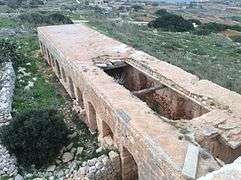 Roofs in a dilapidated state
Roofs in a dilapidated state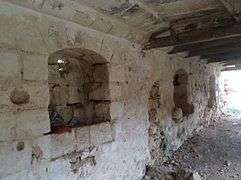
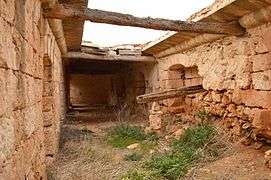 Collapsed roof
Collapsed roof The animal's feeding quarters
The animal's feeding quarters One of the former entrances to the farm
One of the former entrances to the farm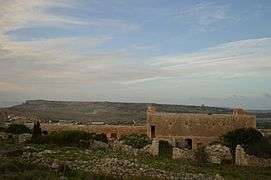 The whole complex of the farm
The whole complex of the farm The arched ceiling is a late example of architecture by the Knights
The arched ceiling is a late example of architecture by the Knights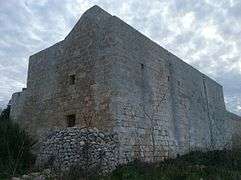 Backside of the farmhouse
Backside of the farmhouse The girna at the front of the farmhouse
The girna at the front of the farmhouse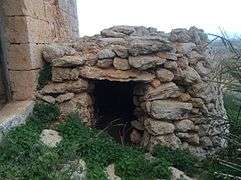 The girna at the side of the farmhouse
The girna at the side of the farmhouse A view from the farmhouse and the two staircases that are said to appear as horns
A view from the farmhouse and the two staircases that are said to appear as horns
Further reading
- Mahoney, Leonardo (1996). 5,000 Years of Architecture in Malta. Malta: Valletta Publishing. Format. pp. 123–124. ISBN 9990958157. ISBN 9789990958157.
References
- ↑ MEPA (June 2016). "North West Local Plans". Public Consultancy Draft. Malta Environment and Planning Authority (MEPA).
- 1 2 Zammit, Anne (2014), "Farmers and fireworks don't mix". Times of Malta.
- 1 2 Muscat, David (2013). "Mill-Migja tal-Gharab sa tmiem il-hakma tal-Ordni ta' San Gwann". Imperial Band Club. p. 142.
- 1 2 Huxley, Michael (1986). "The Geographical Magazine, Volume 58". Geographical Press. p. 314.
- 1 2 3 4 5 Mahoney, Leonardo (1996). 5,000 Years of Architecture in Malta. Malta: Valletta Publishing. Format. pp. 123-124. ISBN 9990958157. ISBN 9789990958157.
- 1 2 3 4 5 "Ir-Razzett tax-Xitan".
- 1 2 3 4 Camilleri, Alex. "Il-Mellieha u madwarna". p. 167.
- 1 2 3 Bartolo, Evarist. "The Legend of the Farmhouse the Devils Built". Malta Inside Out.
- ↑ Fenech, Doris. "Maltese Carnival".
- ↑ Fenech, Doris. "Maltese Carnival".
- 1 2 Tabone, Timothy (2 March 2014). "Reject the application for fireworks factory". Times of Malta.
- ↑ Said, Edward (2011). "Collapse of Naxxar building". Times of Malta.
- ↑ Said, Edward (2012). "Government urged to protect historic building facing collapse". Times of Malta.
- ↑ "Gazzetta tal-Gvern ta' Malta". Malta Environment and Planning Authority (MEPA).
- ↑ Unknown (30 December 2012). "125 properties on National Inventory of the Cultural Property". The Malta Independent. Retrieved 10 March 2016.